
Water determines the Great Lakes Region’s economic future
Climate change, geopolitics and business opportunities power a blue economy
Clear plastic bags hang from small spigots plugged into birch trunks in a mixed stand of deciduous and coniferous trees on a hillside above the Kispiox River in northwest B.C. Denzel Sutherland-Wilson and his 19-year-old niece, Hailey Wilson, pour the birch water collected overnight from five trees into a 20-litre bucket, explaining they’ve been doing this every day for a couple of weeks.
“It just tastes like water with a little bit of sweetness,” Sutherland-Wilson says. The 24-year-old Gitxsan of the Gisk’aast (Fireweed) clan sits on a moss-covered log in the morning sun, his camouflage jacket warding off the chill in the northern spring air. He laughs as he says he’s like his clan’s namesake flower, bursting into life as soon as the spring sun melts the snow.
We’re here to talk about logging and non-timber uses of the forest. The province recently initiated the overdue Kispiox timber supply review, which will determine the scale and nature of logging on the land base for the next 10 to 15 years. Currently set at just over one million cubic metres annually, the decision is going to impact the Gitxsan and local loggers, hunters, fishers and ranchers, not to mention the forest ecosystem and its plant and animal inhabitants. The decisions made here will also have implications for other communities in the region, as the trees cut in Kispiox forests are hauled to mills across the northwest.
Tapping birch trees, called
haawak in Gitxsan, is new to the two young Indigenous locals and for now they’re just sharing the water with friends and family. But Sutherland-Wilson says sustainable use and intimate knowledge of the forest aligns with the Gitxsan worldview.
“Having a relationship with all these things is the basis of us wanting to protect it,” he says. “We have a relationship with all these plants and species that our ancestors have kept up for thousands of years. And now it’s our responsibility to keep up that relationship.”
He says he’s not completely opposed to logging, and points out old stumps in the bush, explaining his grandfather logged in the area. But there’s a big difference between dragging a few choice trees out of the bush and punching in a road to provide access for heavy machinery, which can clear vast sections of forest in days or weeks.
“When he’s logging, he always thinks about the future generations and leaves materials for them to create their houses and their cradles and bent boxes. And that’s the opposite of what’s going on.”

Denzel Sutherland-Wilson says Gitxsan youth have a responsibility to develop and maintain a relationship with the forest. Photo: Marty Clemens / The Narwhal
Kispiox rancher and self-professed redneck Gene Allen has cut down a lot of trees in his time. He spits tobacco juice on the ground as he reminisces about logging for spruce in the valley.
“We nuked it right down to the river bottom and then it took 25 years to stabilize the river systems,” he says in a gravelly voice. The septuagenarian’s blue eyes squint in the bright sunlight, deep creases on his face telling the story of a life lived out in the elements. “Man, we lost a lot of really good spawning habitat sites.”
He’s invited me out to visit a woodlot he works with his son, to show what selective logging looks like on the ground. We wander down a skid trail and he points out towering cedars, healthy hemlocks and barely noticeable moss-covered stumps from old horse-logging operations, explaining that local loggers have been cutting from the woodlot since the 1950s.
“Right up the street they logged a block as big as [the] woodlot…in three weeks — flattened it,” he says.
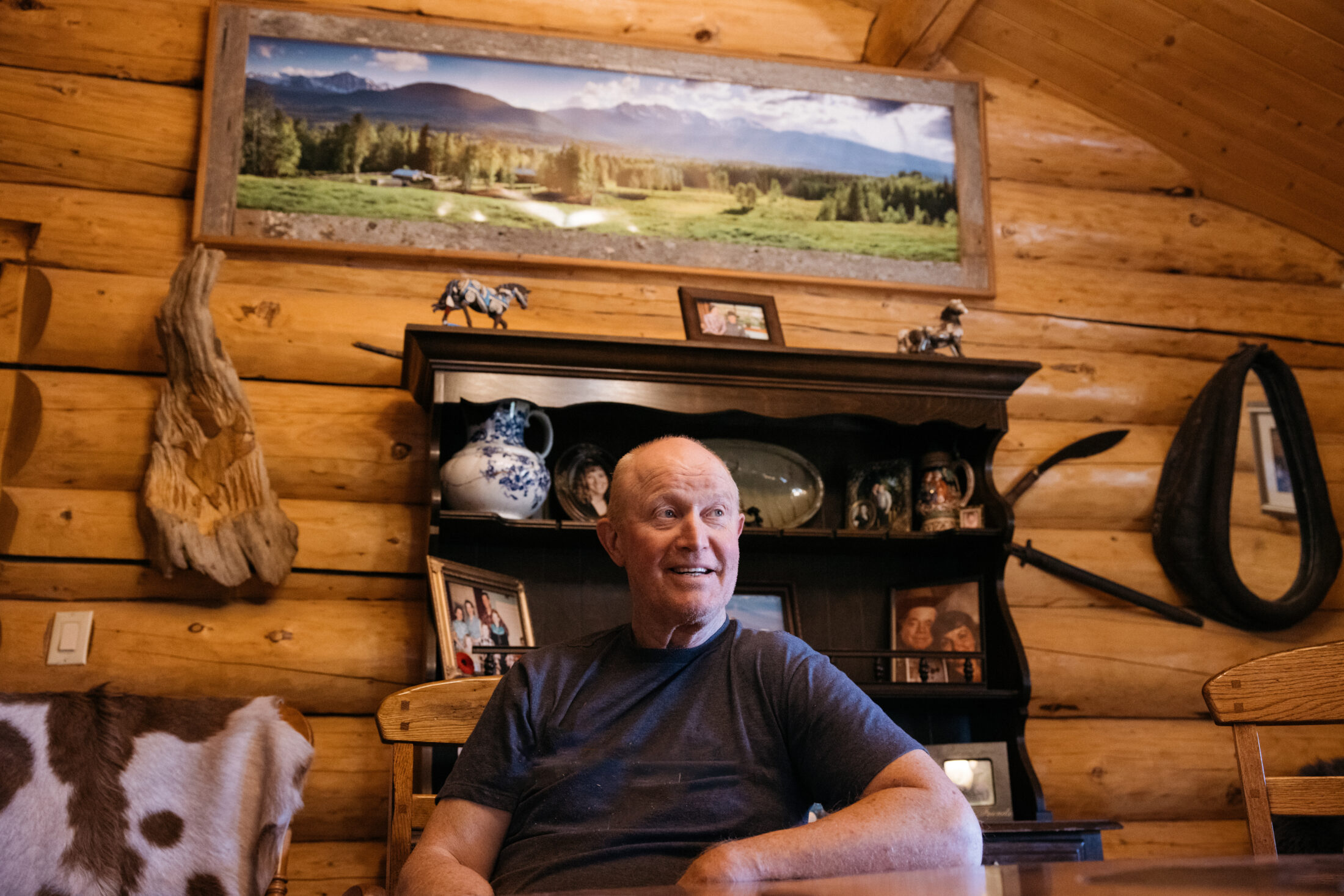
Rancher and self-professed redneck Gene Allen believes sustainable logging is possible but says current policies favour large-scale industrial operations. The photo behind him on the wall is of a landscape now fragmented by clearcuts. Photo: Marty Clemens / The Narwhal
Cedar limbs lie scattered on the forest floor, left in situ to provide nutrients to the soil and shade for new growth. He points out stacks of logs that would be burned in conventional commercial logging operations and lists off all the uses they’ll sell them for: lumber, furniture, fencing and firewood. He also explains how a deciduous species like cottonwood is left or burned in commercial cutblocks, but once properly dried the tree can be used to produce strong, long-lasting lumber. Doing so takes a long time, however, which isn’t an option for logging companies.
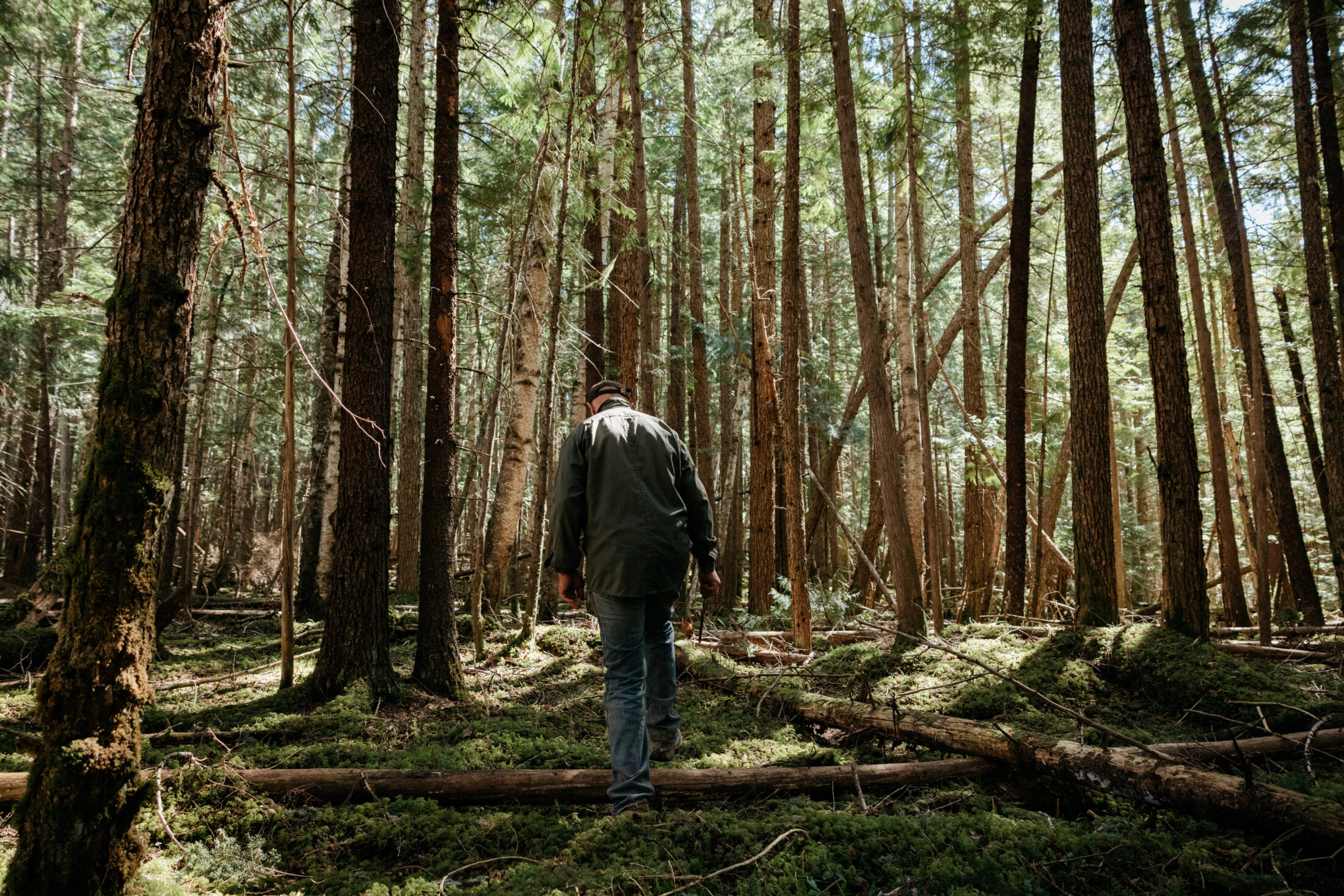
Gene Allen walks through a woodlot, where locals have been selective logging for more than 70 years. Photo: Marty Clemens / The Narwhal
“All the logging is geared to a big industry mentality,” Allen says. “It’s really geared to clearcuts and big equipment — it’s more economical to take what you want and then burn the rest. But it doesn’t have to be that way.”
Deeper into the woodlot he climbs out of his pickup truck and walks across a dusty clearing to a towering pile of wood.
“This is the waste pile from 35 years of logging,” he says with evident pride. In contrast, a single clearcut might produce half a dozen piles of the same size, or larger, in less than a month.

It took 35 years of logging to produce this waste pile. Large industrial operations can produce several piles this size or larger in less than a month. Photo: Marty Clemens / The Narwhal
Allen is not only concerned about how much wood companies are cutting, he’s also frustrated by the lack of local benefits. He says when he was a kid there were over 30 “mom and pop” sawmills in the Kispiox Valley. Now there are fewer than five, producing and selling specialty products like custom cedar lumber.
“You can’t blame the loggers — a lot of these guys are doing export because it’s economically better,” he says, explaining that selling logs to be shipped out can fetch almost double the amount you’d get from selling to smaller mills in the region.
While Allen’s family woodlot is one example of how to make money from the forest, he doesn’t rely on the industry for his livelihood these days and those who do see the situation differently. Rick Carle, a semi-retired logging contractor who lives in the Kispiox Valley, says eking out a living in forestry these days is increasingly hard. Part of the problem, he explains, is the province gives little to no consideration to local loggers and out-of-town companies are often in a better position to secure a cutting licence.
“The province is only concerned about revenue generation; they don’t give a rip about the communities,” he says on a phone call.
Speaking at the annual B.C. Council of Forest Industries conference last month, Premier John Horgan acknowledged that a disproportionate amount of logging rights are controlled by a handful of large companies. He referenced a 2019 letter he wrote to the industry players, calling for voluntary collaboration to support sharing the resources, and said he was disappointed by the lack of progress, hinting at impending government intervention.
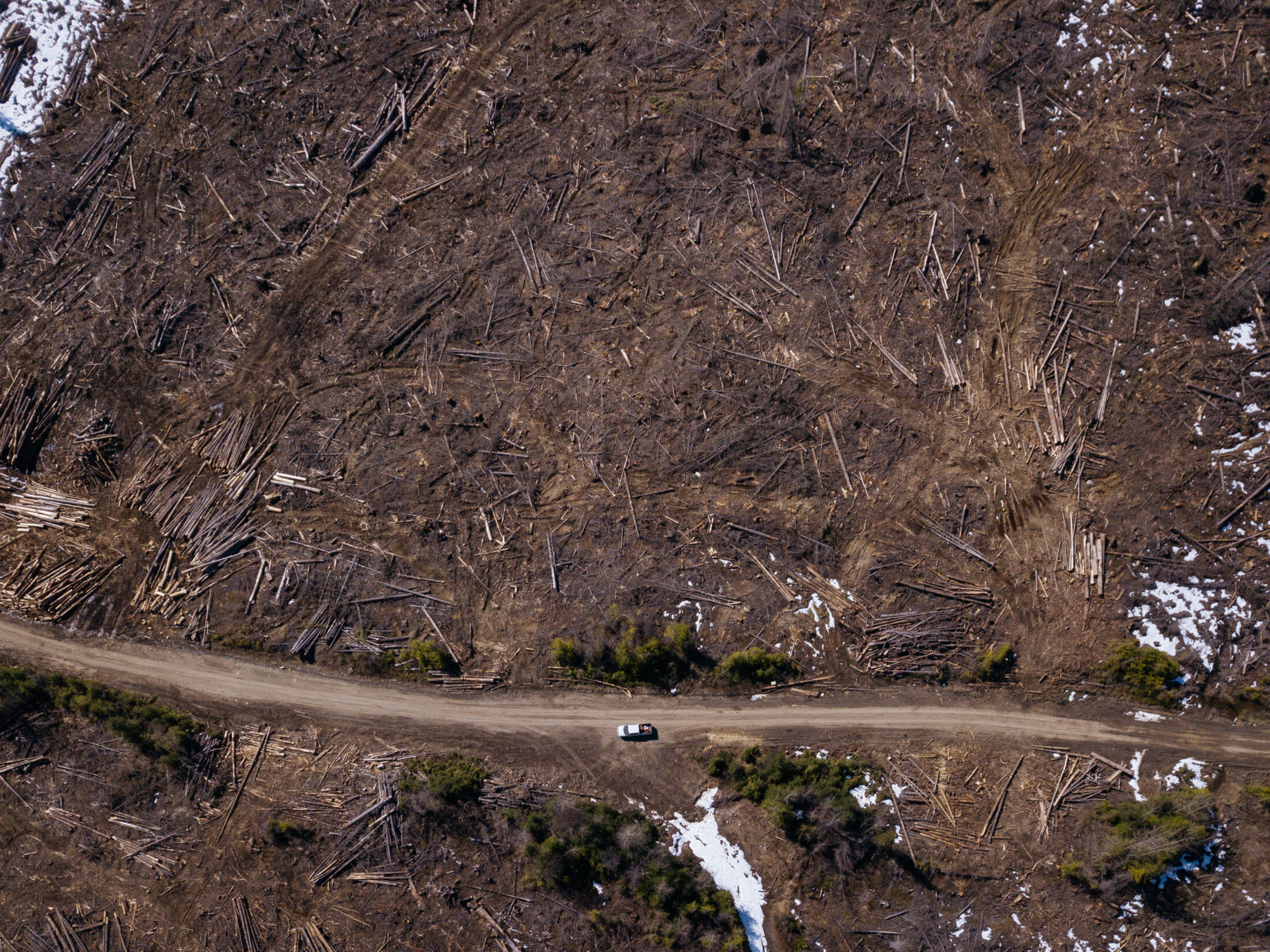
“The Hazleton area is kind of like a sinkhole — the province doesn’t even generate a whole lot of revenue here,” says Rick Carle, a semi-retired logger from the Kispiox Valley. Photo: Marty Clemens / The Narwhal
When the smaller local outfits do get a contract, they’re subject to strict rules and regulations which eat away at their profits. Carle explains he logged a small cutblock last winter and had to partition it to protect for plant habitat and leave behind tall stumps for bird species. “There’s a shit ton of regulation that we have to operate under,” he says. “We jump through lots of hoops.”
Another challenge, he adds, is the way the province manages the region’s forests. The Kispiox timber supply area is classified and regulated as an interior forest, which means the loggers are subject to interior guidelines on what they can sell and what they have to burn. But the reality is much more complex on the ground.
The Kispiox is situated in a transitional zone between coastal and interior forests, which means it’s home to unique biodiversity including a mix of high-value western red cedar and interior spruce and pine. The weather conditions also affect the quality of the wood. Carle says that means an average cutblock includes a large proportion of trees that can only be sold for pulp, but all the pulp mills in the region are closed. And when those trees go into a slash pile, the local companies have to pay extra waste fees.
“The Hazleton area is kind of like a sinkhole — the province doesn’t even generate a whole lot of revenue here,” he says.
He admits he’s a little hesitant to talk to a reporter and warns that a lot of loggers won’t want to share their perspective because they’re so often vilified in the media.
“Sure we work out there every day but we also go out and we hunt and fish and we enjoy camping and stuff, so we want to see it looked after,” he says. “People like to portray loggers as the bad guys, but it pisses me off when I drive up and people are out there mushroom picking and leaving garbage along the side of the road, and in the forest.”
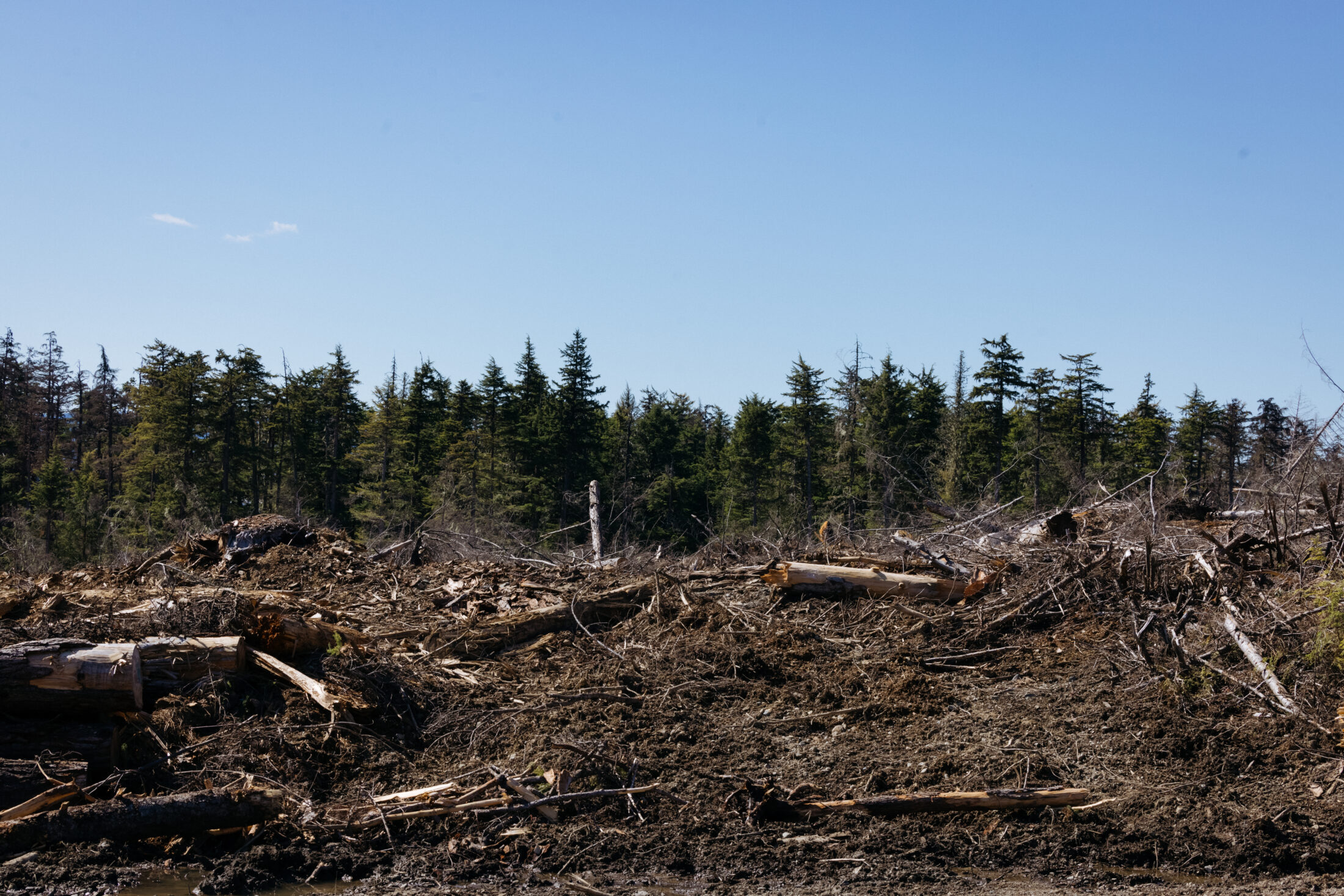
A typical Kispiox cutblock includes trees that can only be sold for pulp, but with no pulp mills left in the region, those trees are burned as waste. Photo: Marty Clemens / The Narwhal
While Allen might not share the same point of view on some of the issues, he agrees what’s happening on the landscape is not the loggers’ fault. Instead, he points the finger squarely at provincial policy.
“Last year, it was so freakin’ wet all summer and nobody got shut down,” he says. “We’re just tearing the shit out of everything, including the environment.”
The spring conditions prevent us from driving to any recent clearcuts but Allen takes me to a vantage point to look at what’s been happening above Date Creek, a tributary of the Kispiox River. The mountainside looks like a patchwork quilt. He says it’s going to get worse before it gets better.
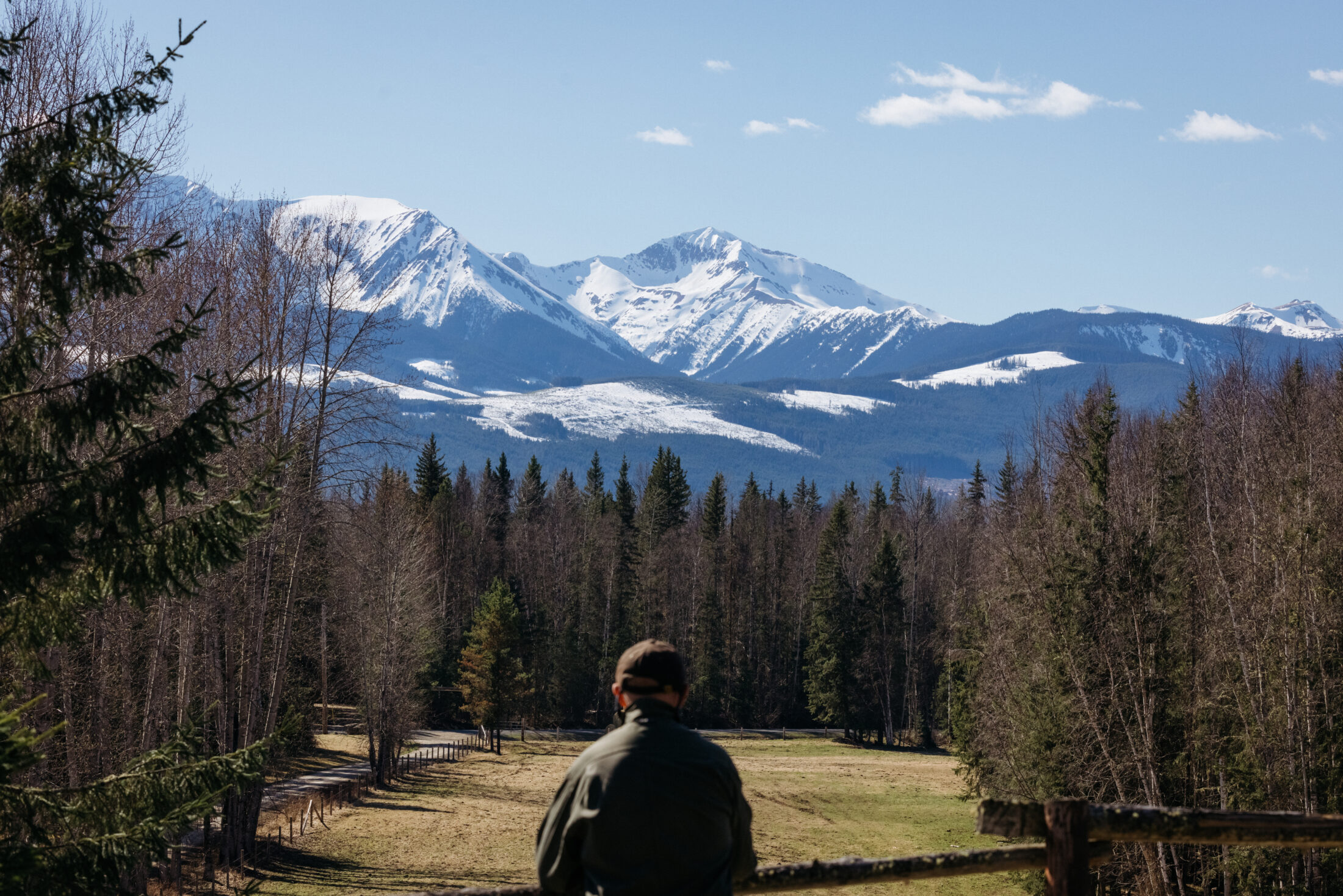
Gene Allen looks across the valley at the logging above Date Creek, which he says is all recent. Photo: Marty Clemens / The Narwhal
Carle argues that while it doesn’t look pretty right now, those cutblocks will regenerate quickly and says he sees logging as long-term farming — as long as the blocks are replanted with a mix of species consistent with the ecology of the region they’ll grow back and be ready to harvest again in around 60 years.
But Sutherland-Wilson says the short-term impacts of logging at the creek’s headwaters are affecting the resource most valued by the Gitxsan: salmon.
“There have been massive changes over the last few years in terms of the salmon-spawning capabilities of this creek because of all that logging going on up there,” he says.
The higher elevation clearcuts mean the snow melts faster in the spring and the runoff washes sediment into the creek, all of which changes the depth, flow and dynamics of the aquatic habitat. There are ways to lessen those impacts by reducing the size of cutblocks and choosing locations where the increased runoff won’t reach the creek, according to a 2006 Canadian Journal of Forest Research study. But Allen says plans are underway for more logging in the area, further up the mountain and above the headwaters.

Denzel Sutherland-Wilson says he caught his first fish at the mouth of Date Creek. He worries that more clearcutting above the creek’s headwaters will continue to impact the watershed’s salmon spawning habitat. Photo: Marty Clemens / The Narwhal
In response to questions about Kispiox forest management, the province says cutting levels have been far below the allowable limits for market and economic reasons. Between 2010 and 2019, the average harvest was just 25 per cent of the annual allowable cut, topping out at 41 per cent in 2017, according to a statement from the Ministry of Forests, Lands, Natural Resource Operations and Rural Development.
On paper, that leaves a lot of room to expand, but according to Allen and Carle the logging activity in the 1.3 million hectare Kispiox timber supply area is concentrated in just a few locations that are easier to access, which means the numbers don’t accurately represent what is taking place on the landscape.
“For the last probably 15 years the Kispiox has been grossly undercut,” Carle says. “The problem is certain watersheds are being almost over cut. Because of financial constraints, there are only certain areas that are really viable.”

This woodlot in the Kispiox Valley has been selectively logged for more than 70 years. Photo: Marty Clemens / The Narwhal
B.C.’s Chief Forester Diane Nicholls is responsible for signing off on the decision that will determine how much forest can be cut down over the next decade or longer. On a phone call, she explains her role has limitations, but she can take steps to ensure the harvest is spread out across the land base.
“If I put what we call a partition — so I segregate out a certain area for whatever reason — I can limit the amount of harvest [in] a certain area for whatever reason,” Nicholls says. “It’s not a mathematical equation, it’s a professional judgment.”
In February, when the province took the first step in the timber supply review — publishing a data package that will inform the entire process up to and including the annual allowable cut determination — numerous stakeholders quickly responded. They pointed out flaws ranging from mislabelled charts and tables to massive gaps in the data, including an alarming lack of transparency about modelling assumptions. The modelling assumptions will, among other things, determine what’s called the base case, establishing how much forest is out there right now and how much will be left after logging, accounting for projections of regrowth and other variables like wildfire and the impacts of climate change.
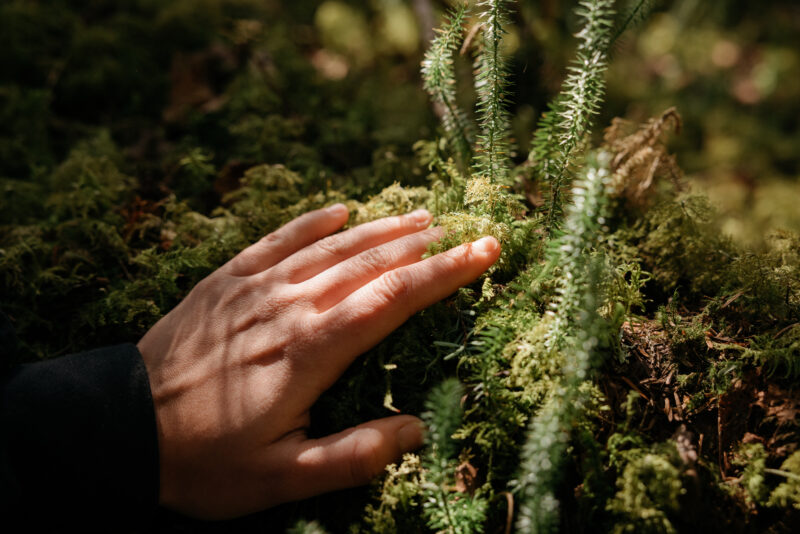
The province recently initiated the timber supply review for the Kispiox region. The process relies on modelling assumptions, including projections of regrowth. Photo: Marty Clemens / The Narwhal

As climate change continues to impact forest ecosystems, the province has to develop strategies to ensure replanting after logging activity is successful. Photo: Marty Clemens / The Narwhal
Sarah Railton, a Terrace-based forester and consultant working with SkeenaWild Conservation Trust, says she’s concerned about the errors and the lack of transparency given the data package is meant to play a pivotal role in the public consultation process.
On a Zoom call, she says one of the flaws is a discrepancy between how the province manages areas where independent companies go above and beyond legal requirements to address local concerns and areas where the licensee is the province’s own forestry outfit, BC Timber Sales, which harvests just under a quarter of B.C.’s annual allowable cut.
“I’m going to use this word, and it’s sort of shocking but it’s true: it’s an incestuous system,” she says. “We have government saying, ‘Listen, our hands are tied — licensees aren’t abiding by it.’ And the one licensee actually not abiding by it is the government.”
Read more: The government agency at the centre of B.C.’s old-growth logging showdown
Railton says inconsistency and other glaring errors in the information presented to the public make it nearly impossible for any meaningful engagement.
“The lack of transparency leads to insufficient information on which to base public consultation.” While she says the timber supply review process doesn’t present much opportunity for policy reform, she notes the province agreed to extend the deadline for public comment to June 30.
Nicholls says she’s cautious about granting extensions, especially when there’s a question of whether current levels of logging are sustainable, because any delays to the decision mean more wood will be cut in the interim. But because logging in the Kispiox amounts to less than half what is allowed, she agreed.
“We hear a lot from local communities and individuals that really care about the forest in their backyard,” she says. “We bring that forward into the timber supply review process and it’s part of the things that I consider in my determinations.”
Railton says she wants to make sure the process is fair and based on the highest quality science.
“The opportunities for the [timber sales review] process are more transparency, better data, better modelling and more clarity on assumptions,” she says. “Because assumptions are what underlies all these decisions at the end of the day.”

Gitxsan youth Hailey Wilson dips her hand in Date Creek, a tributary of the Kispiox River. B.C.’s Chief Forester Diane Nicholls says the timber supply review process provides an opportunity for locals to share concerns with the province and those concerns inform her final decision. Photo: Marty Clemens / The Narwhal
Joining Railton on the call is Len Vanderstar, an ecosystems biologist who worked for the provincial government for 25 years. He says the problems with forest management are complex, and the way the technical material is presented — even without any errors — means the average person, including those most likely to be directly impacted by the decisions, can’t engage. He says he doesn’t have any faith in the timber supply review process so he’s joined forces with foresters and scientists across the province to call for a review of the review itself.
“We have a responsibility to inform the public that forestry is not sustainable in British Columbia,” he says. “And our level of cuts are not realistic, the determination is not realistic.”
The kicker, he says, is that it’s entirely possible to log B.C. forests sustainably, both for ecosystem health and economy. “If you have a healthy, functional ecosystem, you can have healthy functional economies and society.”
Railton agrees and says the policy needs to shift its focus from extraction to protection.
“We’re not intentional and deliberate about what we are leaving, we are only intentional and deliberate about what we are taking, based on the markets of the day.”
She says the public has a role to play at a grassroots level. “It’s all well and great to have a local sawmill but when push comes to shove, are you buying your bookshelves at IKEA or are you going to go down the road and buy them from your local mill?”
While forestry will continue to play a role in the future of the Kispiox Valley, whether it is selective logging from a woodlot or clearcutting hillsides to feed the few remaining mills in the northwest, some locals are looking at alternative ways to use and make money from the forest.
In March, Skeena Watershed Conservation Coalition published a report exploring opportunities for non-timber forestry businesses, with a focus on birch beverages. The idea is to encourage Indigenous and non-Indigenous collaboration to reap benefits from the Kispiox forests, without having to cut down as many trees.
Tapping birch trees for water or sap, when done correctly, doesn’t harm the tree. And the water, quickly becoming a health trend, is delicious.
With the sound of horses in the fields and the spring chatter of birds in the background, I accept a glass poured by Allen’s wife, Joy. As Sutherland-Wilson said, it has a hint of sweetness and it’s just a tiny bit more viscous than water.
That viscosity and flavour recently caught the attention of a small local brewery.
In early April, the owners of Smithers Brewing Co. tapped about 100 trees in the Kispiox Valley and collected more than 1,000 litres of birch water, which they’re now using to brew a special edition Bohemian pilsner.
“We took that whole thing of the four main ingredients in beer and eliminated the biggest one,” Blaine Etsby, one of the brewery’s owners, says. “We can basically say we don’t use water in that beer.”
Head brewer Cam McKeigan says he’s pretty sure it’s a first in B.C. — maybe even Canada. The trick to pulling it off, he explains, is collecting the amount needed quickly enough as the birch water has a very short shelf-life unless frozen or pasteurized. “We figured we’d have to harvest 1,500 litres without killing any trees, and we had to do it in four days or less,” he laughs. They collected around 1,300 litres and the beer should be ready by mid-May.

Smithers Brewing Co. tapped about 100 birch trees in the Kispiox Valley to brew a special edition Bohemian pilsner. Photo: Marty Clemens / The Narwhal
The concept of non-timber use of the forest is close to Natasha Kuperman’s heart. She works on an expansive project called Seed the North, which at its heart is about protecting nature-based food sovereignty in the face of climate change.
“At the scale I want to work at, we’re supporting an ecosystem becoming robust,” she says as she shows me around her property on Wilp (house group) Luudkudziiwus in Gitxsan territory. “We’re doing that by planting for biodiversity, by selecting species of Indigenous value, selecting species that fix nitrogen and improve the soil and species that attract birds and bears and bees.”
She laughs frequently and has an immense amount of energy, half-skipping instead of walking as she explains the multiple construction projects underway: a seed lab that will be built out of old shipping containers, a cottonwood cabin for knowledge transfer workshops and wood sheds to facilitate drying and curing wood. She talks a mile a minute, leaping from subject to subject, continually referencing mentors and collaborators. Like many residents in the region, Kuperman has a pragmatic view and is seeking solutions that support everyone in the community.
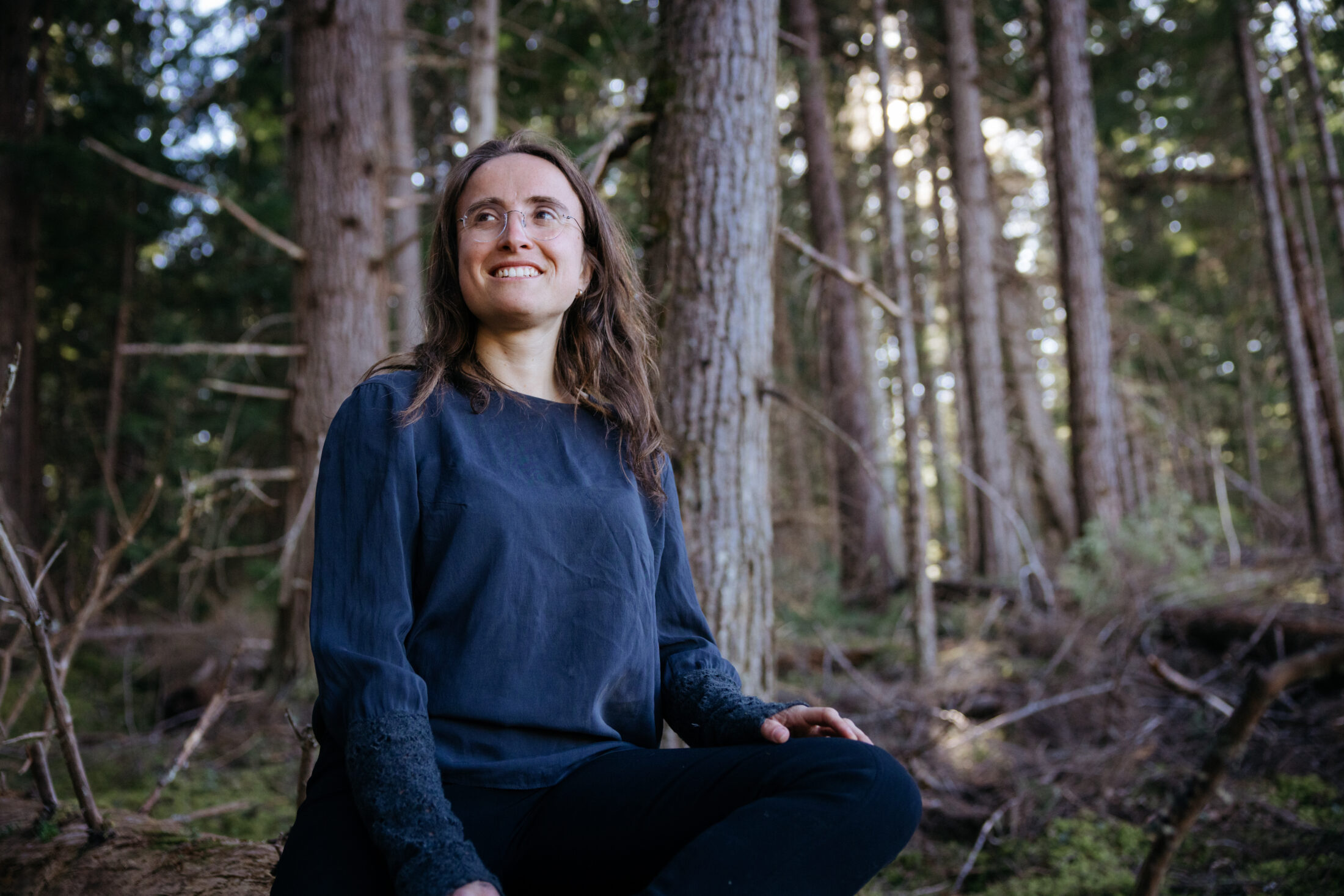
Natasha Kuperman’s property on Wilp (house group) Luudkudziiwus in Gitxsan territory is the headquarters for Seed the North, a forest restoration initiative. Photo: Marty Clemens / The Narwhal
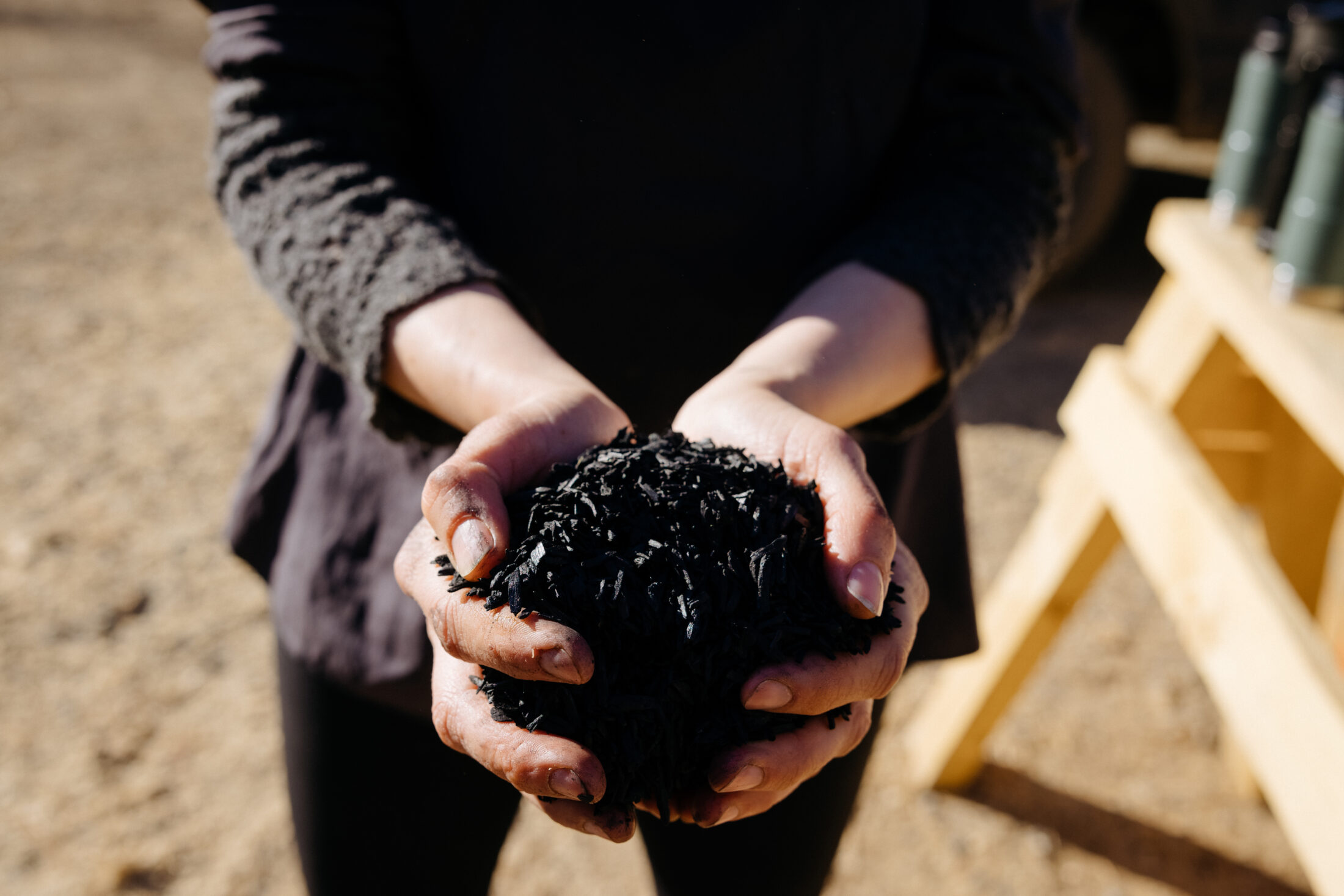
Seed the North uses biochar, an organic material made from waste wood, to protect seeds and assist in the germination process. Photo: Marty Clemens / The Narwhal
“It’s not that logging is problematic — it’s the way that it’s done,” she says as we look down over a wetland, which she says represents a part of the forest typically overlooked in management decisions. “I can’t even begin to articulate all of the endemic entrenched problems of making a policy perfect for the south and applying it to the north. There are better ways.”
Allen points out that mushroom cultivation is another efficient and sustainable use of deciduous or mixed forest. He says in the heyday of big spruce logging in the valley he’d often harvest mushrooms before he left the bush.
“I picked my hard-hat full of mushrooms at the end of the day in this patch I was falling and I made more with that hard-hat of mushrooms than I made falling trees,” he laughs. “That’s a sustainable resource that comes back year after year and there’s so much pine mushroom habitat that we’re nuking, where mushrooms will never grow again.”
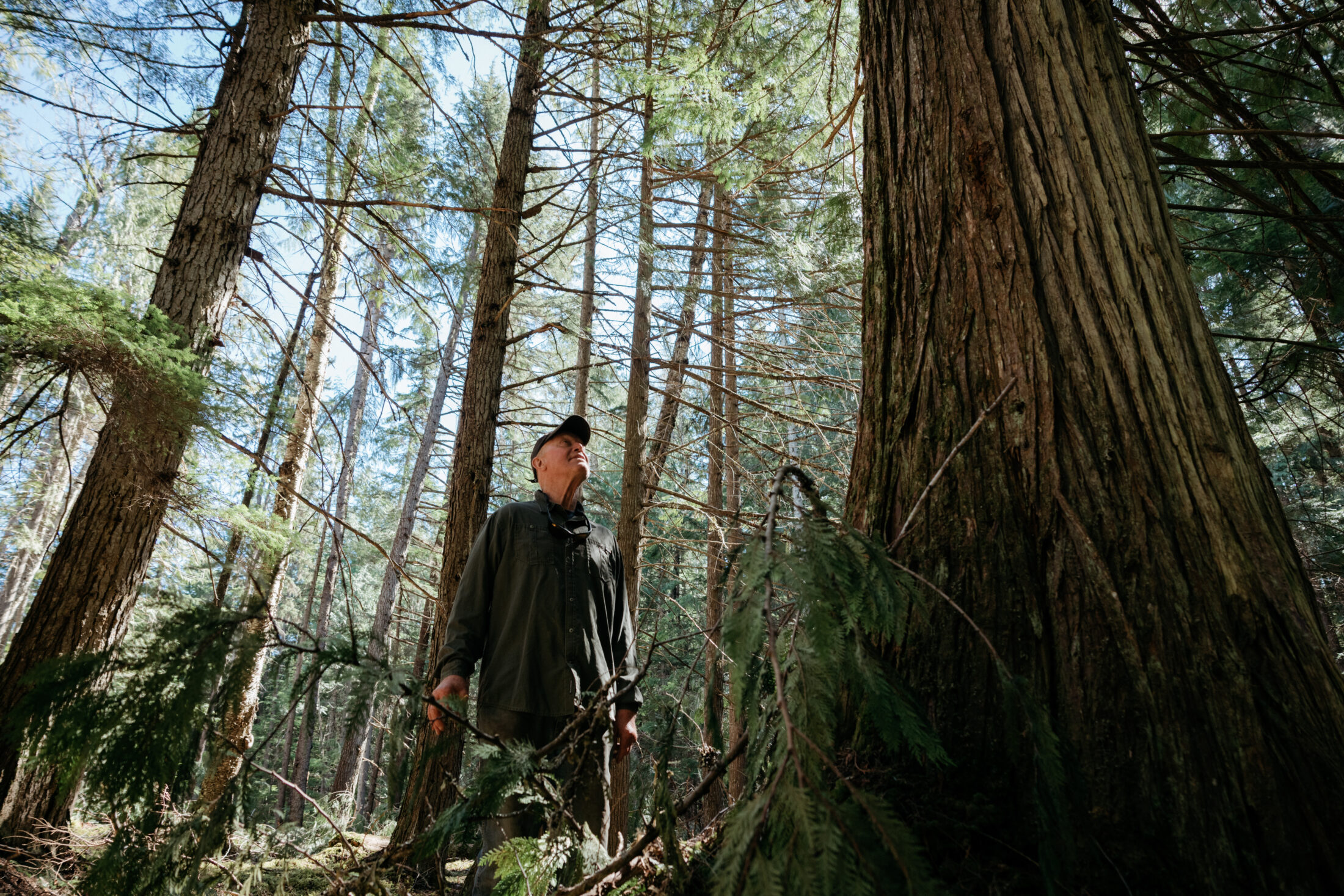
Gene Allen looks at a cedar on the family woodlot. He says they leave trees like this one standing to help keep the forest healthy for years to come. Photo: Marty Clemens / The Narwhal
Sutherland-Wilson says by learning about things like tapping haawak and exploring alternative uses of the forest he is focusing on the future.
“It’s not just our culture. It’s like, these things are what help us be good relatives to our territories, and how we can take care of them properly for the future generations.”
He attributes a lot of his knowledge to his father but admits he’s also picking up bits and pieces from non-traditional sources and collaborating with Indigenous and non-Indigenous people alike.
“I learned how to skin a beaver from a white dude on YouTube,” he laughs.
He’s been taking his niece out in the forest to teach her about Gitxsan land stewardship and to help her feel empowered. He explains it’s important to support the next generation right in front of you. Wilson crouches on the ground, fiddling with a twig, the dyed highlights in her hair catching the light. She says she grew up in the bush, but her connection to the land was broken when her family relocated.
“Moving into town I just kind of felt lost,” she says. “Like there was nothing for me to do.”
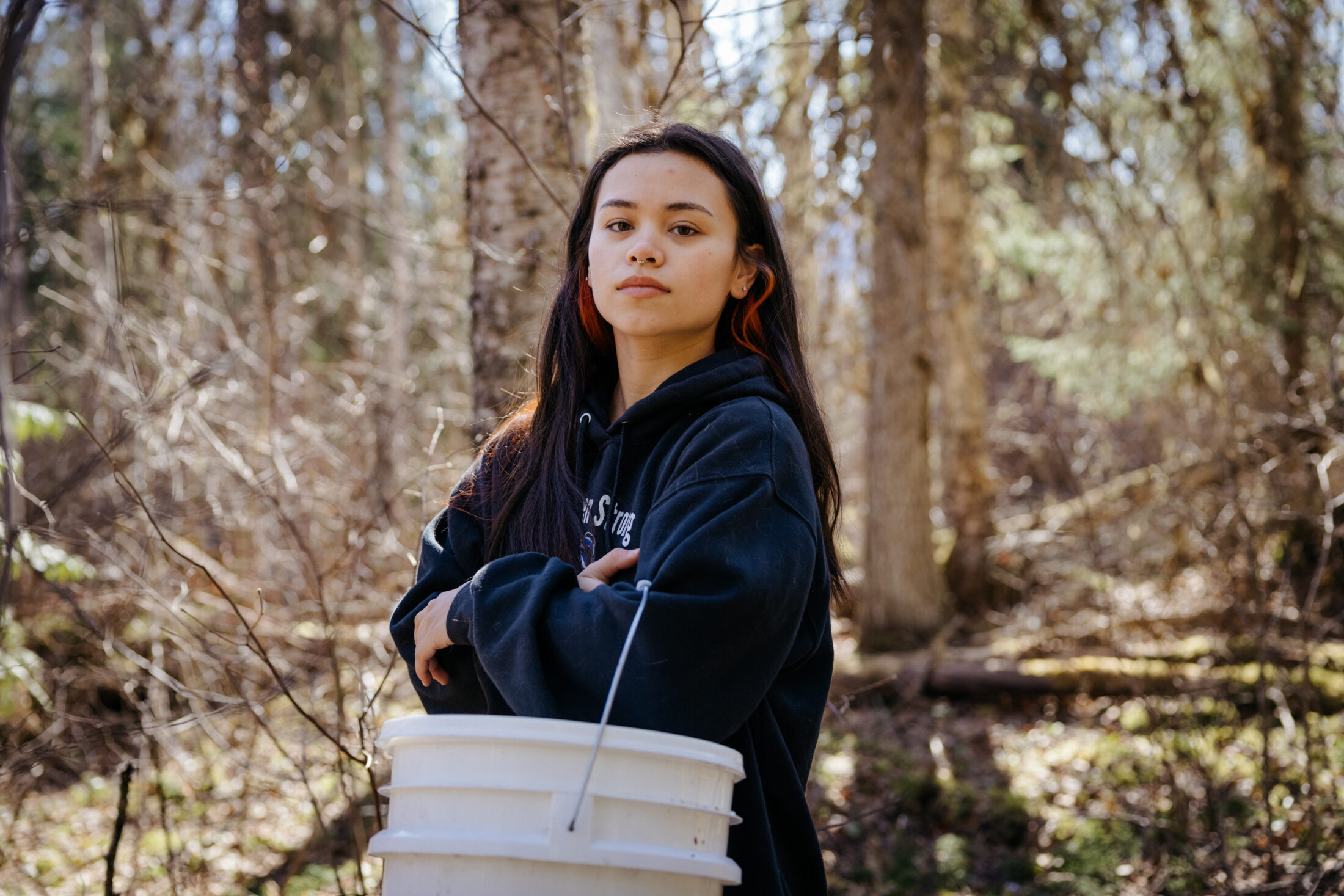
Hailey Wilson says she’s learning about Gitxsan culture and responsibilities from her uncles and grandfather and plans to pass the knowledge on to her younger siblings. “It makes me feel fulfilled, so I want that for them, too,” she says. Photo: Marty Clemens / The Narwhal
Now, with the support of her uncle and others, she’s rebuilding those connections. “I feel like I’m lucky to have so many people around me that know so much about my culture.”
She says she plans to pass on everything she’s learning to her younger siblings. “I’m trying to learn as much as I can from my uncles and my grandpa so I can teach them. It makes me feel fulfilled, so I want that for them, too.”
Sutherland-Wilson grins, clearly a proud uncle. “She’s gonna be a big chief someday.”
Updated May 11, 2021, at 10:07 a.m. PT: This article has been updated to clarify that while the Allen family woodlot has been selectively logged for over 70 years, it has not been in the family for that length of time.
Get the inside scoop on The Narwhal’s environment and climate reporting by signing up for our free newsletter. On a warm September evening nearly 15...
Continue reading
Climate change, geopolitics and business opportunities power a blue economy

10 billion litres of sewage are dumped into Winnipeg’s lakes and rivers each year. Some...

Court sides with Xatśūll First Nation, temporarily halting Mount Polley mine waste expansion
